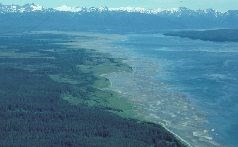
World War II changed the face of Alaska and Glacier Bay, essentially ushering in the modern world to this remote region. In 1941 an airfield and associated facilities were constructed at Gustavus. An even more ambitious—and highly secret—project began in August 1942, two months after a Japanese fleet launched an attack on the American military base at Dutch Harbor. This was construction of a huge supply terminal at Excursion Inlet, just east of the monument boundary. Completed in November 1943, the terminal covered more than 600 acres and included over 800 buildings and three large docks. Fortunately or unfortunately, the main theater of war operations had by the time of its completion moved beyond Alaska, and the facility was used for only a few months. In June 1945 700 German POWs were shipped to Excursion Inlet to dismantle the terminal. Some of the salvaged material was used to help rebuild the village of Hoonah, which had suffered a devastating fire in June 1944. Turned over to civilian use following the war, the Gustavus airfield proved to be a windfall for both the monument and the local economy. Prior to the war, Park Service planners had envisioned a lodge and administration area at Sandy Cove, accessible only by boat. Now Bartlett Cove, which could be linked to the new airport by a few miles of road, became the focus of development plans. Vociferous appeals from local homesteaders, as well as support from national conservation organizations, resulted in the removal of more than 14,000 acres of land, including the Gustavus airport, from the monument in 1955. |
Last updated: November 13, 2025
